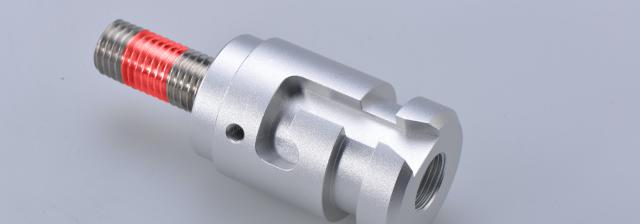Definition
Threadlocker is a chemical product used to prevent screws and bolts from loosening unintentionally due to vibrations, cyclic loads, or temperature changes. It can be applied to the threads of screws before their installation, forming a layer of adhesive material that solidifies once the screw is tightened.

The different types
There are two main types of threadlockers:
- Permanent threadlocker, designed for long-term use and providing a very strong bond. It’s often used in applications where a screw or bolt must never come loose, such as in the aerospace or automotive industry for securing critical components. It requires significant force to loosen the screw or bolt.
- Temporary threadlocker, designed for short-term use and allowing easy disassembly with standard tools. It’s often used in applications where the screw or bolt needs to be easily removed, such as for maintenance purposes. It can be removed by applying reasonable force with an appropriate tool.
In addition to these two main types, there are also variations for specific applications, such as low-strength threadlockers for applications where clamping force needs to be minimal, or high-temperature threadlockers for applications subjected to extreme temperatures.
Comparison with other fastening methods
Compared to other fastening methods, threadlocker offers several advantages:
- Locknuts: Using a locknut is a common method to prevent screws from loosening. However, this method often requires the use of two wrenches, which can be challenging in hard-to-reach places. Threadlocker, on the other hand, can be applied to the screw’s threads before installation and doesn’t require the use of a locknut.
- Lock washers: Lock washers are special washers used to prevent screws from loosening. However, they are not always effective and often need to be replaced after a certain time. Threadlocker, in contrast, provides permanent protection against loosening.
- Thread adhesives: Thread adhesives are similar chemical products to threadlocker but are designed to permanently bond fasteners in place. While these adhesives are effective, they often make disassembly of the fastener impossible without cutting it. Temporary threadlocker, on the other hand, allows for easy disassembly.
How does threadlocker work?
Explanation of the chemical reaction
The chemical reaction that occurs when threadlocker is applied to the screw’s threads depends on the type of threadlocker being used. However, generally speaking, it is an anaerobic adhesive that polymerizes in the absence of air (oxygen) and metal. When applied to the screw’s threads, it infiltrates the gaps between the threads.
The threadlocker polymerizes, forming a solid synthetic resin that fills the empty spaces between the threads. This adhesive material provides resistance to sliding and twisting, thereby preventing the screw from loosening. The polymerization time varies depending on the type of threadlocker used. Permanent ones require more time to fully polymerize, while temporary ones are designed to polymerize quickly to allow for easy disassembly.
Usage

Applications
Threadlocker is widely used in the automotive, aerospace, and construction industries where safety and reliability are paramount. Here are some examples of applications in these fields:
- Automotive Industry:
- Fastening brake discs and wheels
- Fastening suspension components
- Fastening engine components
- Fastening transmission system elements
- Aerospace Industry:
- Fastening aircraft structural elements, such as panels and cell parts
- Fastening aircraft engines and propellers
- Fastening hydraulic and electrical system components
- Construction Industry:
- Fastening beams, columns, and steel reinforcement bars
- Fastening roofing system elements
- Fastening façade system elements
In all of these fields, threadlocker is used to prevent screws and bolts from loosening due to vibrations, cyclic loads, or temperature changes. It enhances the safety and reliability of structures and systems, thereby reducing the risks of failure and accidents.
Home applications
Here are some examples of threadlocker usage in a domestic context:
- Furniture assembly: Furniture can experience vibrations and regular movements, which can cause screws to loosen over time. Applying threadlocker to the screws used to assemble furniture can help prevent this issue.
- Repairing small appliances: Small household appliances like blenders and coffee machines may also have screws that loosen over time. Applying threadlocker can help keep these screws in place and extend the lifespan of the appliance.
- Wall panel fixation: Wall panels can be secured with screws that may loosen over time due to vibrations and wear. Using threadlocker on these screws can help maintain the panels in place.
It’s important to note that using threadlocker for domestic applications should be done with caution and only when necessary. It’s essential to carefully read the instructions on the product packaging and choose the appropriate type of product based on the specific application.
How to apply it?
- Make sure the surface is clean and dry. Clean the screw and bolt threads using an appropriate solvent to remove any residue or contamination.
- Select the appropriate threadlocker based on the screw size and application. Make sure to choose the right type (permanent or temporary) based on your needs.
- Apply the threadlocker to the screw threads. Use an adequate amount to completely cover the screw threads, but avoid applying too much to prevent excess material. A.C.E.S. has become a specialist in threadlocker application on threaded parts.
- Tighten the screw to the recommended tension using a suitable tightening tool. The recommended tension depends on the screw size and application.
- Allow the threadlocker to dry for the recommended duration. This period can vary depending on the type of threadlocker used. During this time, avoid touching or moving the screw to allow the product to solidify properly.
Tips for choosing the right type
When choosing a threadlocker for a specific application, it’s important to consider several factors to select the appropriate type. Here are some tips to consider:
- Load Type: The first thing to consider is the type of load that the screw or bolt needs to bear. If the load is constant and long-term, you’ll need a permanent threadlocker that offers maximum resistance to loosening. If the load is temporary or if you need to disassemble the screw later, a temporary threadlocker would be more appropriate.
- Thread Type: Threadlockers are designed to work with different thread types. It’s important to choose the threadlocker that best suits the type of thread you’re using.
- Operating Temperature: The operating temperature range should also be considered when choosing the type of threadlocker. If the application is in a high-temperature environment, you’ll need a threadlocker capable of withstanding that temperature.
- Material Type: If you’re working with specific materials, such as plastic, rubber, or composites, it’s important to choose a product that won’t corrode or damage the material.
- Clamping Force: The clamping force of the screw or bolt should also be taken into account. If the screw is subjected to a strong clamping force, a more resistant threadlocker should be used.
